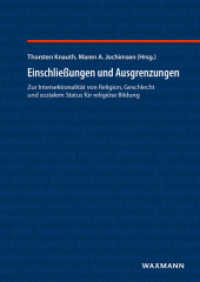- ホーム
- > 洋書
- > 英文書
- > Business / Economics
Full Description
Conventional methods and models for spatial data analysis are based on 'hard' (quantitative, cardinally-measured) information. Approaches such as location-allocation models, optimization models, entropy models, spatial assignment models and regional growth models all re flect the past trend to cast complex and multidimensional spatial interaction patterns in the framework of a cardinal metric system. In recent years, significant progress has been made in the analysis of 'soft', qualitative or categoricaily-measured data. In the fields of both parametric and non-parametric statistics and econometrics, a wide variety of techniques and models have been designed which treat qualitative variables in an appropriate manner. All these methods and techniques aim at taking into account the limitations caused by measuring variables on a non-metric scale, and try to avoid ‾he use of non-permissible numerical operations on qualitative variables. These endeavors have resulted in new catch phrases for the analysis of qualitative data, such as 'soft econometrics', etc. Researchers in the areas of regional and urban economics, geography and planning have become increasingly aware of the necessity to in corporate qualitative data and a wide array of methods for quali tative data are now being applied. Applications have included, for instance, spatial consumer choice behavior, locational perceptions and preferences, contingency table analysis, spatial scenario analysis, qualitative impact analysis, project and plan evaluations, spatial conflict analysis, and so forth.
Contents
Qualitative Spatial Data Analysis: A Compendium of Approaches.- A. Generalized Linear Models and Categorical Data.- Statistical Models for Qualitative Data.- Statistical and Scientific Aspects of Models for Qualitative Data.- Analysis of Qualitative Individual Data and of Latent Class Models with Generalized Linear Models.- Categorical Regression Models for Contextual Analysis; A Comparison of Logit and Linear Probability Models.- Multivariate Contingency Table Analysis with NONMET: Basic Ideas.- Categorical Data Methods and Discrete Choice Modelling in Spatial Analysis: Some Directions for the 1980s.- B. Log-Linear Models.- Hybrid Log-Linear Models.- A Comparison of the Loglinear Interaction Model with Other Spatial Interaction Models.- Modelling Cross-Tabulated Regional Data.- C. Partial Least Squares and Lisrel models.- Systems Analysis by Partial Least Squares.- Recent Developments on Categorical Data Analysis by PLS.- Soft Modelling and Spatial Econometrics: Towards an Integrated Approach.- Structural Equation Models with Qualitative Observed Variables.- D. Multidimensional Qualitative Analysis.- Multidimensional Data Analysis for Categorical Variables.- Analyzing Activity Pattern Data Using Qualitative Multivariate Statistical Methods.- Unemployment and the Rise of National Socialism: Contradicting Results from Different Regional Aggregations.- Generalized Path Analysis for Mixed Geographical Data.- Order-Dependent Measures of Correspondence for Comparing Proximity Matrices and Related Structures.- A Survey of Qualitative Multiple Criteria Choice Models.- E. Fuzzy and Qualitative Structures.- A Linguistically-Based Regional Classification System.- Fuzzy Data Analysis in a Spatial Context.- Qualitative Structure Analysis of Complex Systems.- F. Discrete Choice Models and Dynamics Analysis.- Trends and Prospects for Qualitative Disaggregate Spatial Choice Models.- The Analysis of Panel Data for Discrete Choices.- Travel-Activity Behavior in Time and Space: Methods for Representation and Analysis.- Dynamic Analysis of Qualitative Variables: Applications to Organizational Demography.- Mathematical Specification of Transportation Models.- General Representational Formalisms and Search Procedures for Inferring Models from Categorical Data.- G. Synthesis.- Developing Trends in Qualitative Spatial Data Analysis.








